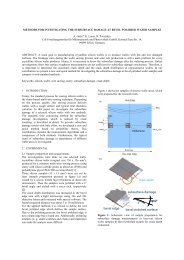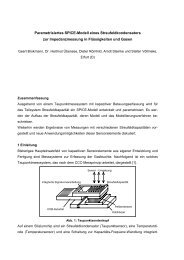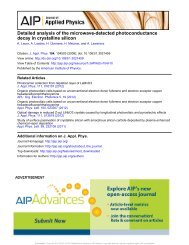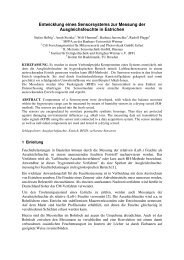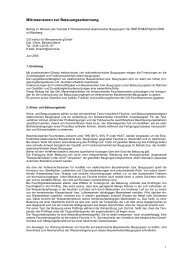SELECTIVE LASER ABLATION OF DIELECTRIC LAYERS ... - CiS
SELECTIVE LASER ABLATION OF DIELECTRIC LAYERS ... - CiS
SELECTIVE LASER ABLATION OF DIELECTRIC LAYERS ... - CiS
You also want an ePaper? Increase the reach of your titles
YUMPU automatically turns print PDFs into web optimized ePapers that Google loves.
<strong>SELECTIVE</strong> <strong>LASER</strong> <strong>ABLATION</strong> <strong>OF</strong> <strong>DIELECTRIC</strong> <strong>LAYERS</strong><br />
S. A. G. D. Correia a,* , J. Lossen a , M. Wald a , K. Neckermann b , M. Bähr b<br />
a Ersol Solar Energy AG,<br />
Wilhelm-Wolff-Str. 23, D-99099 Erfurt, Germany<br />
b Solar Zentrum Erfurt – <strong>CiS</strong> Institut für Mikrosensorik GmbH,<br />
Konrad-Zuse-Straße 14, 99099 Erfurt, Germany<br />
ABSTRACT: In this work we have investigated the local opening of dielectric layers on silicon with a laser. We<br />
have observed the influence of the laser wavelength and energy on the effectiveness of the selective removal of SiN x<br />
and SiO x layers. The induced laser damage was quantified by lifetime measurements. Further we have investigated<br />
the influence of the laser wavelength and pulse energy on the doping profile of an underlying phosphorous emitter.<br />
The ablations were performed with nanosecond lasers with wavelengths of 355 nm, 532nm and 1064 nm<br />
respectively.<br />
Keywords: selective laser ablation, laser assisted decomposition, laser assisted evaporation.<br />
1 INTRODUCTION<br />
In this work we investigate how successfully<br />
nanosecond pulse laser energy can be used to remove a<br />
dielectric layer from a silicon substrate using 355 nm,<br />
532 nm and 1064 nm wavelength lasers.<br />
That process becomes challenging for SiN x and SiO x<br />
dielectric layers because their optical absorption<br />
coefficients are lower than that of the underlying silicon<br />
substrate for the mentioned wavelengths.<br />
Previous works from A. Grohe et. al [1] and P.<br />
Engelhart et. al [2], provided some insights on the<br />
subject of local opening of dielectric layers in Si using<br />
nanosecond lasers with 355 nm, 532 nm, 1064 nm<br />
wavelengths.<br />
Our intent in this work is to gain a better insight<br />
about the basic phenomena and factors influencing this<br />
process.<br />
1.1 Laser Mater Interaction<br />
Laser-matter interaction depends on several physical<br />
parameters such as, wavelength, pulse energy and pulse<br />
duration (τp), besides the thermodynamic properties of<br />
the material. Important to consider in this work are the<br />
effect of the laser wavelength, energy and pulse duration.<br />
The laser interaction with matter can be described in<br />
different time scales. When a laser beam is absorbed by a<br />
material the existing free electrons will receive energy<br />
from the photon electro-magnetic field and oscillate. That<br />
energy will be then transmitted to other electrons and<br />
later to the lattice. If the laser pulse duration is smaller<br />
than the electron cooling time (τp ~1ns>> τl, where τl is lattice heating time, the<br />
electron and lattice are able to reach thermal equilibrium.<br />
This leads to a heat diffusion dominated energy loss<br />
mechanism. This way the material melts and evaporates.<br />
The picosecond regime can be treated as an intermediate<br />
regime between the nanosecond and femtosecond regime.<br />
At last, when τp >> 1ms, the process can be completely<br />
modelled by classical heat transfer [3].<br />
The thermal penetration depth of a laser pulse is<br />
given by,<br />
L = κτ .<br />
D p<br />
were κ is the material thermal diffusivity. LD can be used<br />
to calculate the material heat affected zone.<br />
The material absorption coefficient, α will determine<br />
how deep a photon beam from a certain wavelength will<br />
penetrate in the material until it is amount completely<br />
absorbed. The optical penetration depth, taken from the<br />
Lambert-Beer law will be given by α -1 .<br />
Figure 1 shows the optical absorption curves of C-Si,<br />
Si 3N 4 and SiO 2 [4]. From this graphic the differences in<br />
the absorption coefficients from the three materials are<br />
evident. It is, however, known from the literature that the<br />
absorption coefficient of SiN x can be different from zero<br />
above the 355 nm wavelengths [1] [5]. In this work we<br />
assume that the optical absorption of the SiN x and SiO x<br />
layers here used are negligible when compared to the<br />
optical absorption of Si. This assumption is confirmed by<br />
[5] in the case of SiN x.<br />
Figure 1: Optical Absorption coefficients for Si, Si 3N 4<br />
and SiO 2.<br />
2 METHODOLOGY<br />
We have created test structures of approx. 10mm x<br />
5mm on differently prepared 156mm x 156mm p-type<br />
Cz-wafers with 10-17Ωcm base resistivity. These wafers<br />
where pre-processed in 8 different groups accordingly to<br />
Table 1.
Table 1 – Experimental Groups.<br />
The wafers from group 1, 3, 5 and 7 were coated with<br />
Plasma Enhanced Chemical Vapour Deposited SiN x,<br />
while the wafers from group 2, 4, 6 and 8 were coated<br />
with Atmospheric Plasma Chemical Vapour Deposited<br />
SiO x.<br />
On each wafer there were created 7 x 3 structures<br />
named marks. Each mark corresponded to a specific<br />
pulse fluence (J/cm 2 ). This way, seven marks were<br />
opened at each of the three different wavelengths as<br />
represented in Figure 2.<br />
Figure 2: Organization of the structures opened at<br />
different energies and wavelengths. The structures are<br />
name as ‘mark #’. The marks on each column were<br />
opened using the same wavelength and the marks on each<br />
line were opened with approximately the same fluences.<br />
In this experiment we have used 1064 nm wavelength<br />
pulses of approximately 200 ns of duration. The pulses of<br />
the 355 nm and 532 nm wavelength lasers had durations<br />
between 10 ns and 35 ns.<br />
The following graphic shows the experimental<br />
parameters used in the experiment.<br />
Figure 3: Graphic of the fluences used to open the<br />
structures at different wavelengths. The error for the<br />
fluences used on mark 1 and 2 is about 400 mJ/cm 2 . The<br />
error for the fluences used on marks 3, 4, 5, 6 and 7 is<br />
about 50 mJ/cm 2 .<br />
The opened structures were investigated by optical<br />
and electron microscopy. Subsequently the influence of<br />
the laser energy on the remaining silicon substrate was<br />
investigated by local life time measurements using the<br />
microwave photo conductance decay method (µWPCD).<br />
The effects of the laser energy on the phosphorous<br />
diffused emitter profiles and the presence of N 2 and H 2<br />
were investigated by Secondary Ion Mass Spectrometry<br />
(SIMS).<br />
3 RESULTS AND DISCUSSION<br />
3.1 Visual analysis<br />
The pictures from figure 4 and figure 5 show the<br />
differences in results obtained among shiny etched<br />
wafers with different coatings.<br />
In the pictures one can see inhomogeneities in the<br />
structures opened with the 532 nm laser. This<br />
inhomogeinities were caused by the laser pulse energy<br />
variation due to an internal software error in our laser’s<br />
automation control. This way the pulse energy becomes<br />
slightly bigger than the programmed value when the laser<br />
travels at lower speeds during its acceleration or<br />
deceleration. The real pulse energy only matches the<br />
programmed one when the beam is passing in the middle<br />
of the mark. The influence of that overlapping error is<br />
then bigger and better identifiable at lower fluences.<br />
The quality of the opening on each structure was<br />
attributed considering the percentage of coating free<br />
surface and the presence of any visually identifiable<br />
damage. An extreme melting or the existence of grooves<br />
in the surface is qualified as damage. The best opening<br />
for all the SiN x coated wafers was observed in mark 4,<br />
for the 355 nm laser, mark 3 for the 532 nm laser and<br />
mark 2 for the 1064 nm wavelength laser respectively.<br />
Figure 4: Picture of the structures opened on a wafer<br />
from group 5. The number on the side of each structure<br />
corresponds to its mark number. From the left to the right<br />
the best opened structures correspond to mark 2, mark 3<br />
and mark 4. The structures from middle column are<br />
inhomogeneous due to an undesired pulse energy<br />
variation.<br />
The best openings for the SiO x coated wafers were<br />
observed in mark 3, mark 2 and again mark 2 for the 355<br />
nm, 532 nm and 1064 nm wavelengths, respectively.<br />
This shows that the SiO x layer required more energy to<br />
opened when using the same laser wavelength.
Figure 5: Picture of the structures opened on a shiny<br />
etched SiO x coated wafer. The numbers on the side of<br />
each structure indicate its mark number. From the left to<br />
the right the best opened marks are mark 2, mark 2 and<br />
mark 3.<br />
The results also show, as expected, that it requires<br />
less energy to open the structures when using shorter<br />
wavelengths. A smaller optical absorption depth will be<br />
responsible for a higher maximum surface temperature.<br />
The effect of the pulse overlapping should also not be<br />
omitted. This parameter will control the percentage of<br />
opened surface if the used pulse energy is big enough to<br />
cause any damage in the Si/dielectric layer. This means<br />
that with a bigger pulse overlapping it would be possible<br />
to open mark 5, mark 4 and mark 3 in the SiN x coated<br />
wafers for example.<br />
Figure 6 shows a differential interference contrast<br />
microscope picture of mark 4 (at 355 nm) from the SiN x<br />
coated shiny etched wafer shown in figure 4. The vertical<br />
stripes visible on the surface were caused by the effect<br />
overlapping of the laser beam, after each passage of the<br />
laser beam and by the pulse Gaussian spatial energy<br />
distribution. In this picture it can also be seen that the<br />
surface morphology on mark 4 is almost similar to the<br />
morphology of the adjacent SiN x coated region. The<br />
channels seen on the surface of mark 4 are an indication<br />
that a melting process has occurred.<br />
Figure 6: Microscope picture showing the surface<br />
morphology of mark 4 opened with a 355nm wavelength<br />
laser on the wafer from picture 4.<br />
The same surface morphology was observed on the<br />
best marks opened with the 532 nm and 1064 nm<br />
wavelength laser in the shiny etched SiN x coated wafers.<br />
Similar results, with some small differences, were<br />
observed for the best marks on the shiny etched SiO x<br />
coated wafers.<br />
The influence of the texture can be seen in the wafer<br />
from Figure 7. The picture shows the structures opened<br />
on a textured wafer with SiN x coating. We attribute this<br />
effect to the reduced reflectance of the texture surface.<br />
Figure 7: Picture of a textured wafer with SiN x coating<br />
showing that the surface texture leads to a slightly better<br />
opening process due to higher light absorption.<br />
Figure 8 shows the pyramids from the surface of<br />
mark 4 on the wafer from figure 7 for the 355 nm laser.<br />
The rounding of the pyramid tops due to melting is<br />
clearly visible on that figure.<br />
Figure 8: Scanning electron microscope picture of the<br />
surface of mark 4 of a SiN x coated wafer after 355 nm<br />
laser energy absorption. The surface melting is evident.<br />
Figure 9 shows that the deformation of the pyramids<br />
on the surface of mark 5 of the same wafer is smaller but<br />
still visible.<br />
Figure 9: Scanning electron microscope picture of the<br />
surface of mark 5 of a SiN x coated wafer after 355 nm<br />
laser energy absorption. The surface melting is still<br />
detectable.<br />
Figure 10 shows that it is difficult to identify signs of<br />
melting on the surface of mark 6, although some signs of<br />
the dielectric opening are macroscopically visible, as for
the case of figure 6 for example.<br />
Figure 10: Scanning electron microscope picture of the<br />
surface of mark 6 of a SiNx coated wafer after 355 nm<br />
laser energy absorption. The surface melting is not easily<br />
detectable.<br />
3.2 Effective Lifetime Analysis<br />
The analysis of the effective minority lifetime, here<br />
named simply lifetime, is used to quantify the laser<br />
damage created on each structure.<br />
Figure 11 shows the lifetime map of a shiny etched<br />
SiN x coated wafer with emitter. The reader should pay<br />
attention to the fact that the rectangles drawn around<br />
each mark in this figure don’t coincide with the structure<br />
area and have only a demarking purpose.<br />
The lifetime map shows that the lifetime in general<br />
decreases for high applied fluences in the case of the 355<br />
nm and 532 nm laser opened structures and for the first<br />
mark opeed at 1064 nm. Surprisingly the lifetime of the<br />
structures opened with the 1064 nm and 355 nm lasers<br />
show an increase in lifetime, in relation to the wafer<br />
average value, when lower fluences are applied. Further<br />
experiments showed that this phenomenon also can occur<br />
when 532 nm wavelength pulses are used.<br />
Figure 11: Lifetime map of a Shiny etched wafer with a<br />
SiNx coating and emitter. The lifetime decreases for high<br />
applied fluences. For the 1064 nm and 355 nm marks the<br />
lifetime increases for low applied fluences.<br />
The following graphics show the average lifetime<br />
plotted for each mark for wafers from tree different<br />
groups. This lifetime value was determined by averaging<br />
the lifetime values inside the rectangle defined by each<br />
mark.<br />
In all graphics mark 8 corresponds to a reference<br />
lifetime. This lifetime was determined by averaging the<br />
lifetime in an adjacent rectangle with the same<br />
dimensions as the rectangle defined by all the laser<br />
structures together. The lifetimes measured in the<br />
structures with the optimal opening are identified with a<br />
round dot.<br />
The graphic from figure 12 and figure 13 show the<br />
effect caused by the presence of an emitter.<br />
Their analysis shows that the lifetime of the best<br />
openings is smaller than the reference value in the case of<br />
the 355 nm and 532 nm wavelength lasers. The lifetimes<br />
decrease about 2.5 µs (-8.3%) for the first case and about<br />
9 µs (-28%) for the second case. The lifetime in the<br />
structure opened with the 1064 nm laser increases in<br />
about 5 µs (+14%).<br />
In the wafer with no emitter all the lifetimes in the<br />
best structure decrease abruptly in relation to the average<br />
lifetime. However the increase of lifetime for low<br />
fluences is still observed for the IR laser.<br />
Figure 12: Graphic of the effective lifetime measured at<br />
each mark for a shiny etched, SiN x coated wafer with<br />
emitter. The big circles identify the best opened<br />
structures for each wavelength.<br />
Figure 13: Graphic of the effective lifetime measured at<br />
each mark for a shiny etched, SiN x coated wafer with no<br />
emitter. The big circles identify the best opened<br />
structures for each wavelength.<br />
The graphic from figure 14 can be used to compare<br />
the differences in lifetime variation between a SiN x<br />
coated wafer and a SiO x coated wafer. Both wafers have<br />
an emitter. The graphic shows two different things. In<br />
first place the lifetime in the structures opened by the UV<br />
and green lasers varies the same way as for the the SiN x<br />
coated wafers, i.e., the lifetime decreases strongly for<br />
higher fluences and it tends to increase above the<br />
reference value for smaller fluences. The second<br />
information that can be extracted from the graphic is that,<br />
for the 1064 nm laser, the lifetime minimum occurs at a<br />
value below the maximum applied energy.
Figure 14: Effective lifetime measured at each mark for<br />
a shiny etched, SiO x coated wafer with emitter. The big<br />
circles identify the best opened structures for each<br />
wavelength.<br />
3.3 SIMS Analysis<br />
SIMS showed to be an useful technique to investigate<br />
the depth of the laser damage. The following<br />
measurements were performed on the SiN x coated<br />
wafers.<br />
We were interested to learn about the relationship<br />
between the observed changes and the absorbed laser<br />
energies and wavelengths and to analyze the changes<br />
occurred in the emitter doping profiles of the best<br />
obtained structures.<br />
The results show that the measured profiles in the<br />
opened structures were not dramatically changed when<br />
low fluences were applied. For higher fluences the<br />
phosphor surface concentration is reduced by about one<br />
order of magnitude for the case of the 355 nm and 532<br />
nm lasers and more than that for the case of the 1064 nm<br />
laser.<br />
We have then compared the depth at which a specific<br />
concentration was detected with the depth at which that<br />
same concentration was measured in the reference<br />
profile. We classified that difference as a ‘displacement’.<br />
In the optimum marks, it can be seen that the best<br />
structure obtained with the 355 nm laser (mark 4) has an<br />
average displacement of 200 nm while the best structure<br />
obtained with the 532 nm laser (mark 3) has a<br />
displacement of about 170 nm. The best structure<br />
obtained with the 1064 nm laser (mark 2) is very deeply<br />
diffused when compared with the profiles opened with<br />
shorter wavelengths.<br />
Two distinct factors should be considered when<br />
trying to understand the diffusion process occurred with<br />
the 1064 nm laser. First, the optical absorption depth<br />
affects on the maximum surface temperature, which can<br />
be seen when comparing the results obtained for mark 1<br />
between the 355 nm laser and the 532 nm laser. For the<br />
355 nm laser mark 1 the phosphorus was partly<br />
evaporated while for the 1064 nm laser it was not.<br />
Secondly much longer laser pulse durations will cause a<br />
deeper heat diffusion. This can be observed when<br />
comparing the short wavelength lasers (tens of ns of<br />
duration) with the 1064 nm wavelength laser (hundreds<br />
of nanoseconds duration) for the same fluences.<br />
Figure 15: SIMS profiles of phosphorus after ~200 ns<br />
Infra-red laser pulses absorption in a SiN x coated wafer.<br />
The best opened structure was mark 2.<br />
Figure 16: SIMS profiles of phosphorus after >35 ns 532<br />
nm laser pulses absorption in a SiN x coated wafer. The<br />
best opened structure was mark 3.<br />
Figure 17: SIMS profiles of phosphorus after ~10 ns 355<br />
nm laser pulses absorption in a SiN x coated wafer. The<br />
best opened structure was mark 4.<br />
The profiles show in figure 18 and figure 19 indicate<br />
the nitrogen and hydrogen distributions for mark 4, mark<br />
5 and mark 6 and for the 355 nm laser and SiN x coated<br />
wafers.<br />
In figure 18 we see that the concentration of N 2<br />
inside the sample increases strongly for mark 4. This<br />
distribution appears to be related to the Si melting<br />
process. Mark 4 was the mark on which the Si melting<br />
became more clearly visible.
Figure 18: Nitrogen distribution after 355 nm laser<br />
pulses absorption in a SiN x coated wafer. The best<br />
opened structure was mark 4.<br />
The H 2 concentration also increases with applied<br />
laser energy. This redistribution process might explain in<br />
part the increase of lifetime for lower fluences.<br />
Figure 19: Hydrogen distribution after 355 nm laser<br />
pulses absorption in a SiNx coated wafer. The best<br />
opened structure was mark 4.<br />
3.4 Discussion<br />
To explain the results we had a look on the<br />
thermodynamic properties of Si as a semiconductor and<br />
the SiNx and SiOx, both ceramics. Table 2 resumes those<br />
properties [6] [7] [8].<br />
Table 2 – Experimental Groups.<br />
Based on the data from table 2 we explain the local<br />
opening of the dielectric layers by assuming the<br />
following. In first place, and if we consider that all the<br />
laser absorption in the dielectrics is negligible, we are<br />
able to state that the Si behaves as heat source after<br />
having absorbed the laser energy. The maximum<br />
temperature reached on the Si surface and the depth of<br />
the generated temperature field will depend on the optical<br />
absorption coefficient, laser pulse duration and energy,<br />
besides the material thermal properties.<br />
The removal of the SiN x will occur when enough<br />
energy was absorbed from Si to allow the material to<br />
reach a temperature T>1877.9 °C, approximately. At this<br />
point the partial pressure of the N 2 in the SiN x reaches<br />
one atmosphere [7]. This leads to the dielectric<br />
decomposition.<br />
In the case of the SiO x , the material will melt at about<br />
1600°C and form a glass phase. Its evaporation and<br />
subsequent removal should occur at temperatures above<br />
2230°C.<br />
This way we believe that we can explain why the<br />
SiO x required more energy to be removed from the<br />
surface of the wafer and show that there is a process<br />
window where the removal of the dielectric layers can<br />
occur before the evaporation of the Si.<br />
We could say in this case that we are not in presence<br />
of a dielectric laser ablation process, but, more correctly<br />
in the presence of a laser induced thermal<br />
decomposition/evaporation process.<br />
4 CONCLUSION<br />
In this work we have successfully realized the<br />
opening of SiO x and SiN x dielectric layers on Si wafers<br />
for 355 nm, 532 nm and 1064 nm wavelength<br />
nanosecond lasers. The effect the laser energy,<br />
wavelength and duration on the material lifetime and<br />
emitter profile was determined. We have shown that it is<br />
possible to locally open dielectric layers of SiO x and<br />
SiN x at the mentioned wavelengths with minimal heat<br />
damage and dopant redistribution in the Si. We have also<br />
observed that the laser melting of the Si is partly<br />
responsible for the redistribution of the elements existing<br />
on the surface of the material.<br />
The observations done in this work made us assume<br />
the presence of a laser induced heat transfer process. In<br />
this process the thermal energy generated in the Si causes<br />
the subsequent decomposition or melting and evaporation<br />
of the dielectric coatings.<br />
5 AKNOWLEDGEMENTS<br />
We would like to thank, in first place Dr. Karsten<br />
Mayer, from Ersol AG, for is help in the numerical<br />
simulations of heat transfer.<br />
We would also like to thank Dr. Ines Dani from the<br />
Fraunhofer IWS in Dresden, for the SiO x coating work.<br />
6 REFERENCES<br />
[1] A. Grohe et al., Selective Laser Ablation of Anti-<br />
Reflection Coating for Novel Metallization<br />
Techniques, Solar Cells 16 (1996) 591.<br />
[2] P. Engelhart et al., Laser-Processing for High-<br />
Efficiency Solar Cells, Proceedings of the 17th<br />
NREL-Workshop (2007), Vol. I (2002) 903.<br />
[3] P. Y. Lawrence Yao, Hongqiang Chen, Wenwu<br />
Zhang; Time Scale Effects in Laser Material<br />
Removal: a Review; Int J Adv Manuf. Technol.<br />
(2004); DOI 10.1007/s001170-003-2026.<br />
[4] E. D. Palik, Handbook of Optical Constants of<br />
Solids, Volume 1, Academic Press Hand (1998).
[5] W. Soppe, H. Rieffe, A. Weeber, Bulk Passivation of<br />
Silicon Solar Cells Accomplished by Silicon Nitride<br />
Deposited on Industrial Scale by Microwave<br />
PECVD, Progress in Photovoltaics:Research and<br />
Applications (2005); 13:551-569.<br />
[6] W. C. O`Mara, R. B. Herring, L. P. Hunt, Handbook<br />
of Semiconductor Silicon Technology, NOYES<br />
Publications, (1990).<br />
[7] M.W. Barsoum, Fundamentals of Ceramics, Institut<br />
of Physics Publishing Bristol & Philadelphia (2003).<br />
[8] S.M.Sze, Physics of Semiconductor Devices –<br />
Second Edition, John Wiley&Sons (1981).



